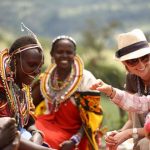
Heritage sites refer to places that carry history from way back. Most of the heritage sites have been inscribed by UNESCO because of the special stories told that existed behind them. Below are the major heritage sites in Uganda;
The Royal Kasubi Tombs
Kasubi tombs belong to Buganda Kingdom. It is a site of the burial grounds of the kings of Buganda and other members of the Buganda royal family. Due to that the site remains an important spiritual and political site for the Baganda and it is also an example of traditional architecture.
Most of the site is agricultural farmed by traditional methods and its core on the hilltop is the former palace of the Kabaka’s of Buganda built in 1882 and turned into a royal burial ground in 1884. The site was inscribed on the UNESCO world heritage list in 2001. The first Kabaka to be buried there was Muteesa 1 the 35th king of Buganda.
The Baganda belong to the Bantu speaking people and date their political civilization back to the 13th century A.D. According to oral traditions, the first Kabaka of Buganda was Kintu who was said to have come with his wife Nambi who he won by performing heroic deeds at the command of her father Ggulu the god of the sky.
The Kabakas buried at Kasubi tombs namely;
- Muteesa 1 from 1835-1884
- Basamula Mwanga II from 1867-1903
- Daudi Chwa II from 1896- 1939
- Fredrick Walugembe Muteesa II from 1924-1969
At Kasubi tombs in all the other royal tombs, there’s an area behind a backcloth called the kibira where certain secret ceremonies are performed.
Bwindi Impenetrable National Park
Bwindi impenetrable national park has been described by UNESCO as an isolated forest of outstanding biological richness. This ancient forest contains more than 160 species of trees and over 100 species of ferns and more famously half of the world’s mountain gorillas.
It is surrounded by one of the most densely populated rural areas in Africa, and community is benefiting from the growing gorilla trekking safaris and other sustainable tourism initiatives and it is the hope for this area to be conserved because they know that they are going to gain from it. Some of the activities carried out at Bwindi jungle besides gorilla trekking include gorilla habituation experience, bird watching, community enounters and foresr nature walks. This is a rich place both with flora and fauna.
And the park is surrounded by the natives called the Batwa who have taken over the forest and have continued to stay around. These people use the forest for a variety of things such as for food, the get building materials, and they are generally based their stay in the area.
The Batwa are described as short people but also very hardworking and given that a number of tourists always go to associate with them whenever they pay a visit to the park. The activity to interact with community members is usually included on the itinerary.
Rwenzori Mountains National Park
It has the third-highest peak in Africa at 5109m above sea level. The combination of spectacular snow-capped peaks glaciers, v-shaped valleys, and fast-flowing rivers with magnificent waterfalls, clear blue lakes and unique flora contributes to the areas natural beauty.
The mountains support the richest montane flora in Africa, encompassing the charismatic giant lobelias, groundsels, and giant heathers which have been called Africa’s botanical big game. The park is located in southwestern Uganda.
It was designated a world heritage site in 1994 because of its outstanding beauty. The Rwenzori Mountain is the highest mountain range in the whole of Africa. The park hosts over 70 mammals, 217 bird species, 19 Albertine rift endemics as well as some of the world’s rarest vegetation. The Rwenzori mountain is the world-class hiking and mountaineering destination. Before the Rwenzori was called the Ruwenzori range located on the border of Uganda and Democratic Republic of Congo.




